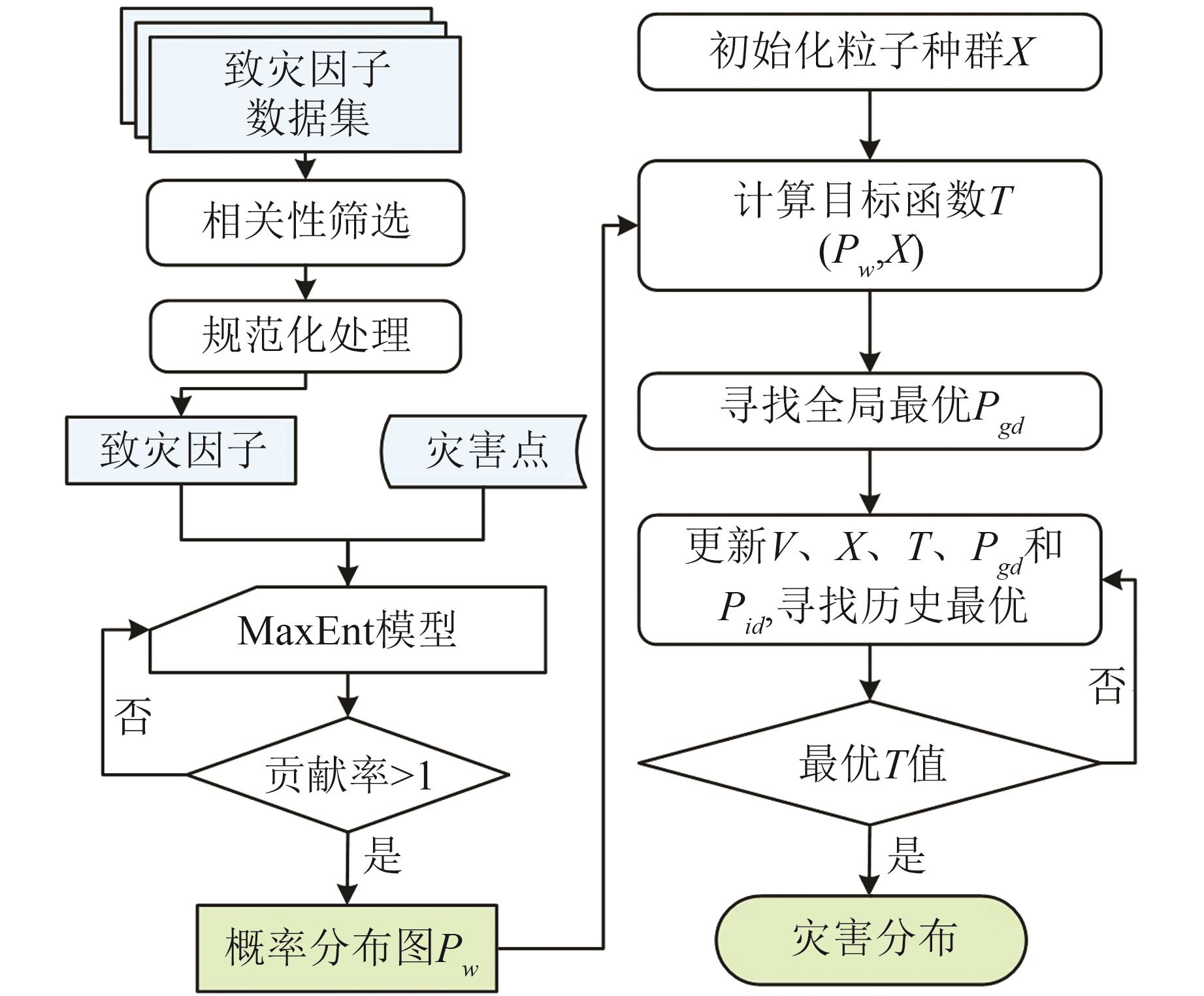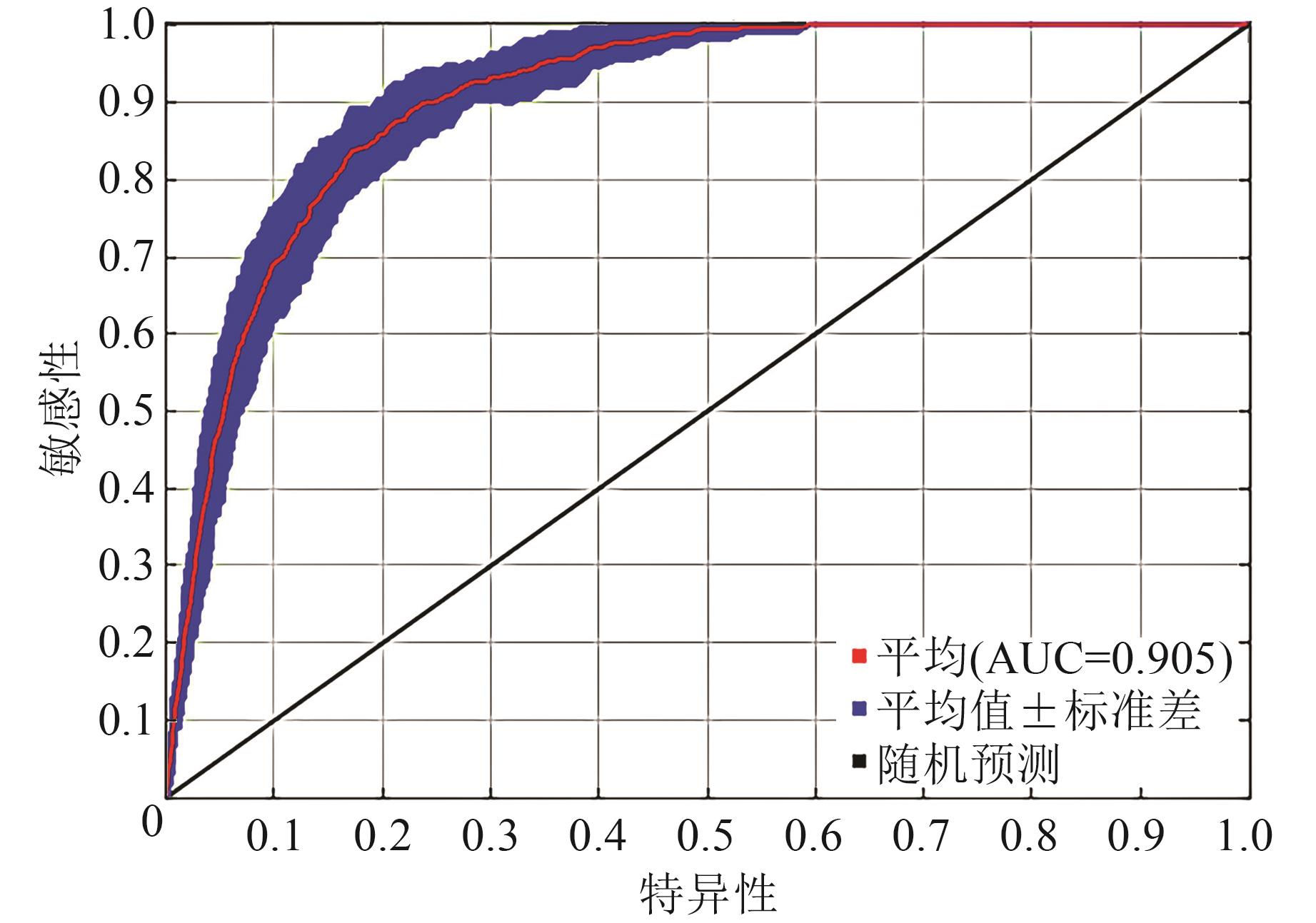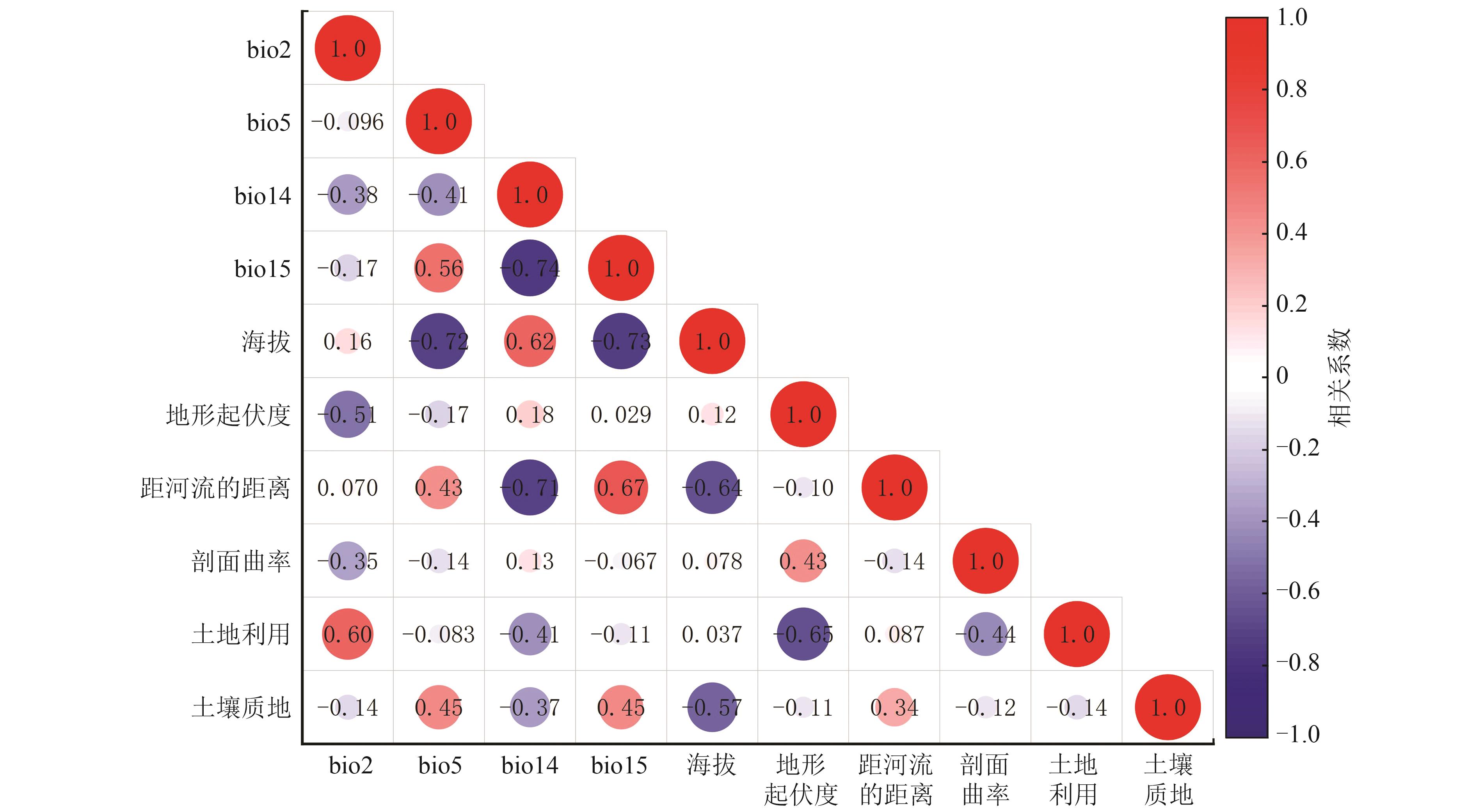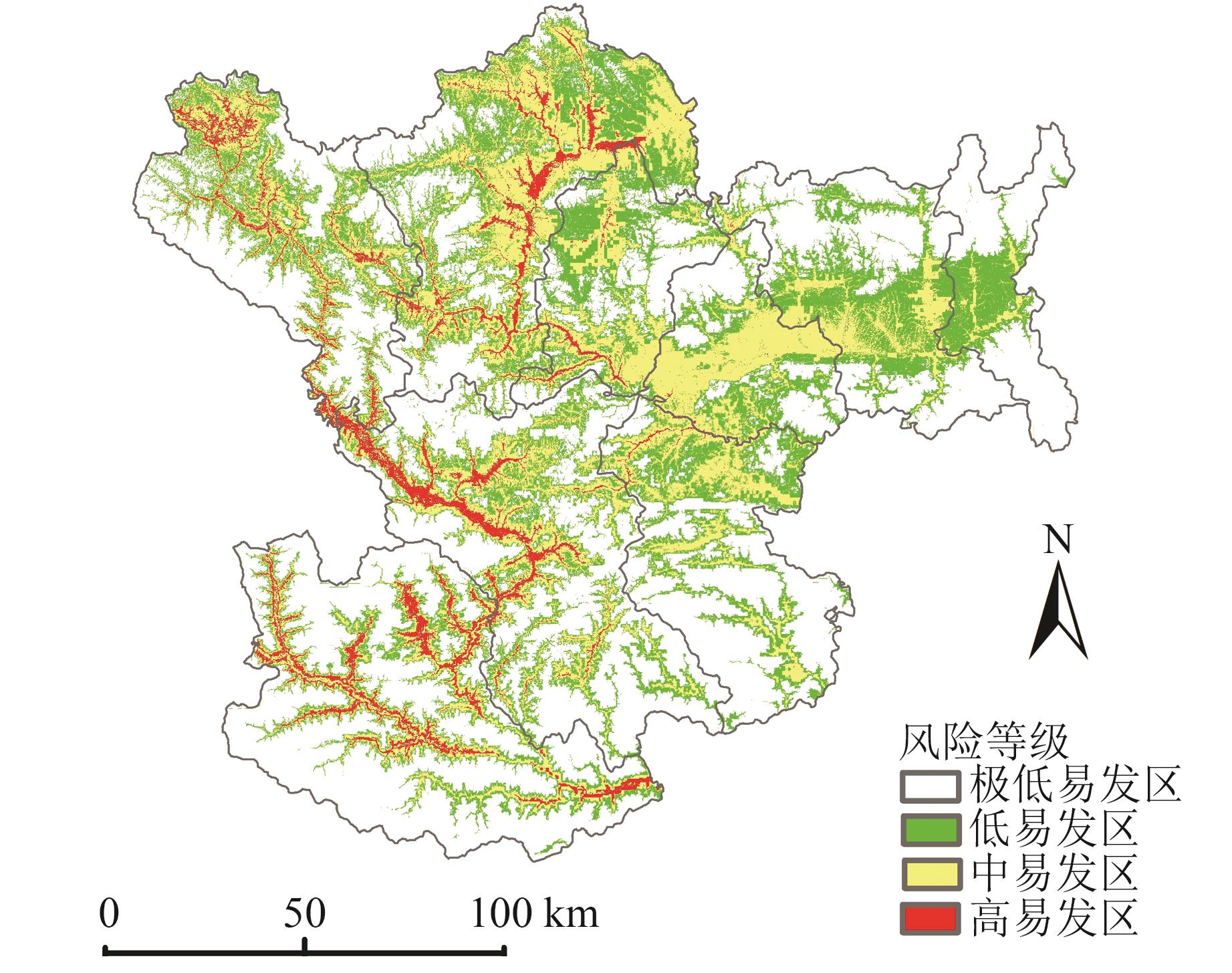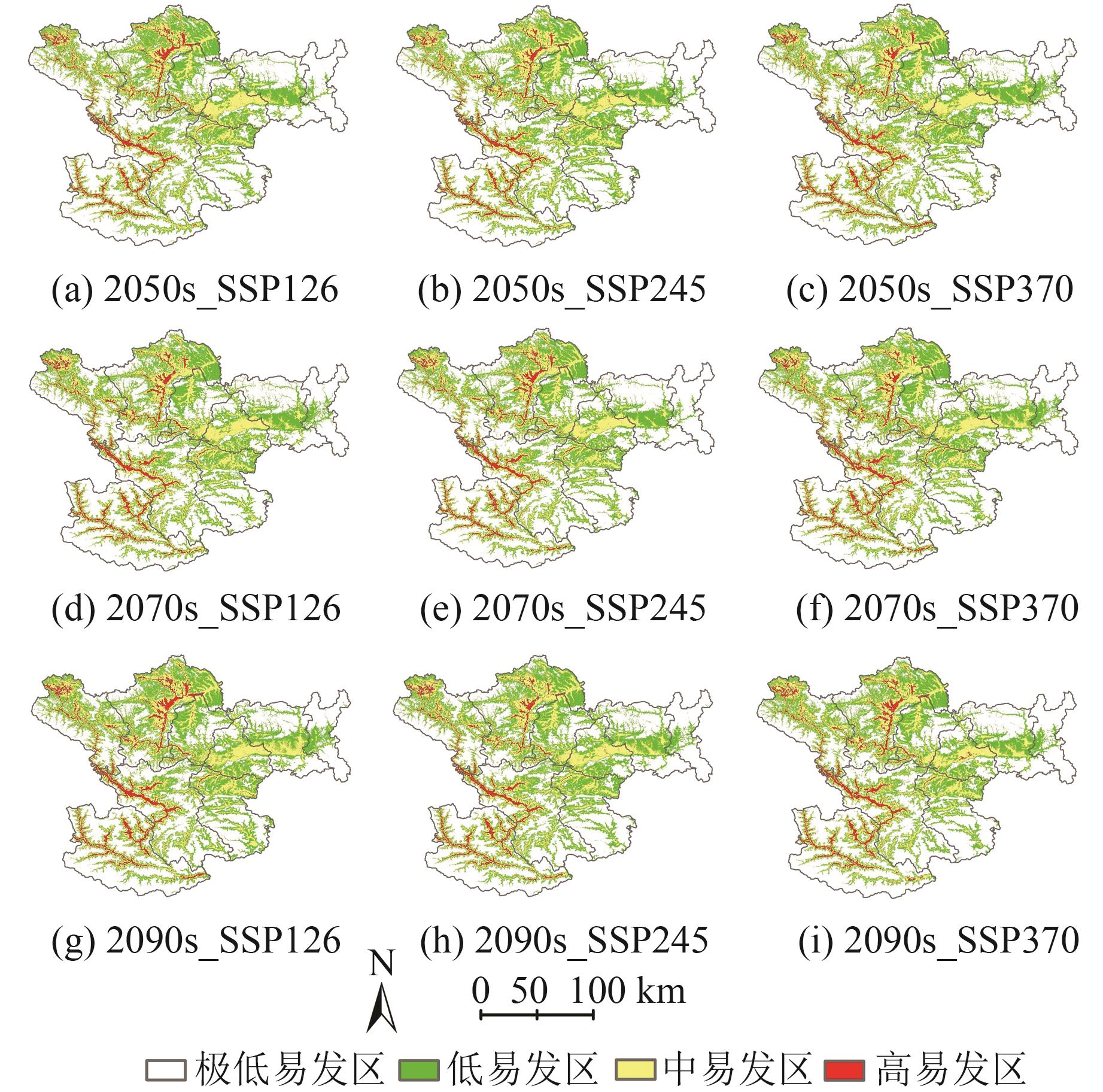Spatial Distribution Prediction of Flash Flood Disaster in Longnan City Based on Particle Swarm Algorithm Combined with MaxEnt Model
-
摘要:
山洪是山区河道水位突然上涨所引发的自然灾害,具有瞬时性、破坏性大等特点。近年来,甘肃省陇南市山洪灾害频发,严重威胁到当地人民的生命财产安全,对该区域进行山洪灾害风险评价刻不容缓。运用MaxEnt结合粒子群优化算法,基于调查的834个山洪灾害点和与灾害相关的32个致灾因子,在探讨主要致灾因子的基础上进行研究区山洪灾害易发性评价,并结合当前(2021—2040年)和未来(2041—2060年、2061—2080年、2081—2100年)4期气候数据的不同情景模式,预测了该区研究期间山洪灾害潜在易发区空间分布格局。结果表明,各期研究结果的受试者工作特征曲线的曲线下面积均大于0.85,表明所提方法的研究结果精度较高;研究区的主要致灾因子为最干月降水量、昼夜温差月均值、降水量变异系数、最暖月最高温、土地利用、距河流的距离、土壤质地、剖面曲率、海拔、地形起伏度;研究区不同时期山洪灾害中高易发区集中分布于武都区、文县和宕昌县部分地区,与当前时期相比,未来3个时期的模拟结果均体现为减少趋势。
Abstract:ObjectivesFlash floods are natural disasters caused by sudden rise in water levels in mountainous rivers, which are characterized by instantaneity and great destructiveness. In recent years, the frequent occurrence of flash floods in Longnan city, Gansu province, has posed a serious threat to the safety of local people's lives and property, thus it is urgent to carry out a risk assessment of flash floods in this region.
MethodsThis study takes Longnan city as the study area, and utilizes the MaxEnt model combining with the particle swarm algorithm to evaluate the vulnerability of study area based on 834 flash flood hazard points investigated and 32 disaster-causing factors. It also predicts the spatial pattern changes and potential mass migration trends of the future flash flood vulnerability areas based on three periods of climate data from the current period (2021—2040) and the future period (2041—2060, 2061—2080, 2081—2100).
Results and ConclusionsThe area under receiver operating characteristic curve of the results of the study in each period is above 0.85, which indicates that the precision of the results of the method is good. The main cause factors in this study area are driest month precipitation, monthly mean diurnal temperature difference, coefficient of variation of precipitation, warmest month maximum temperature, land use, distance from the river, soil texture, profile curvature, elevation, and topographic relief. The flash flood-prone areas in the study area varies in different periods, but are mainly distributed in Wudu District, Wen County and Tanchang County, and the simulation results for the three future periods (2041—2060, 2061—2080, 2081—2100) reflected a decreasing trend compared with the current period (2021—2040).
-
随着中国经济的飞速发展,工业、交通也迅猛发展,城市扩张,人口集中,各种环境问题也层出不穷,其中大气污染,尤其是颗粒物(气溶胶)污染具有广泛的空间分布,对人体健康产生较大危害[1]。空气动力学当量直径小于10 μm的颗粒物被称为PM10,直径小于2.5 μm的颗粒物被称为PM2.5,二者均具有可吸入性,前者通常可以沉积到上呼吸道,而后者可以进入肺泡,对身体危害极大;同时细颗粒物在大气中停留时间长,也影响了大气能见度和大气环境质量[1-3]。
在颗粒物污染监测中,近地表的监测备受人们关注,各个城市中普遍设立了空气质量监测站,同时监测颗粒物浓度(PM10、PM2.5)、硫氧化物、氮氧化物等参数,能够测量站点附近大气污染的详细参数,测量精度高,但受制于成本,不能广泛布站,覆盖区域的测量很难实现,无法全面反映气溶胶的分布。激光雷达作为一种遥感手段,能够进行长距离、高频次的探测,探测结果可以有效反映激光传输路径内的气溶胶分布情况,是当前遥感探测颗粒物污染的有效手段,被广泛应用于城市大气污染探测中[4-11]。国内外多家单位开展了激光雷达用于大气探测的研究,其中中科院安光所[4-7]、武汉大学[8]、西安理工大学[9]等多家国内单位,以及法国索邦大学[10]、日本国立环境研究所[11-12]、意大利[13]、美国NOAA[14]等国外研究机构均利用激光雷达进行了颗粒物探测。
当前国内外的研究中,都是单独进行垂直探测[1, 5, 8-10, 12-17]或者水平探测[4, 6-7],鲜有结合三维探测的激光雷达数据进行相关研究。垂直探测可以确定探测地点上空的气团垂直分布和运动,但是不能获得区域性的颗粒物分布;水平探测可用于识别该区域的颗粒物水平分布,但牺牲了时间分辨率,无法获得颗粒物的传输规律;而同时结合垂直和水平探测组成的三维数据,即可实现两种探测方式的优势互补,从而实现对颗粒物更全面的监测和研究。本文即利用两台微脉冲激光雷达对天津市武清区中心城区进行了全天时的遥感探测,其中一台激光雷达进行垂直测量,探测颗粒物的传输、沉降;另外一台激光雷达架设于高楼顶,进行水平扫描,探测颗粒物的水平分布。通过对两台激光雷达的三维数据的分析,揭示区域性的颗粒物污染分布和传输情况。
1 三维大气污染探测原理与方法
1.1 大气探测激光雷达原理
激光雷达是一种主动探测设备,它向大气中发射激光脉冲,激光束与大气气溶胶粒子和大气分子等发生相互作用,产生回波信号被接收望远镜接收,然后对回波信号进行采集、反演就可以得到大气气溶胶的光学特征信息。激光雷达探测大气颗粒物具有很高的空间和时间分辨率,是目前有效获得大气颗粒物垂直分布廓线的重要手段。
1.2 实验方法和研究区域介绍
本文研究中为了获取大气颗粒物的三维数据,同时采用了两台激光雷达分别进行大气垂直和水平扫描探测。垂直探测和水平扫描激光雷达的技术指标如表 1所示。在大气激光雷达探测中一般采用的是Nd:YAG激光器的基频光,即1 064 nm,因此本文采用的激光雷达的激光波长均为1 064 nm。同时对激光雷达进行了一体化设计,并加入窄带滤光片,使得其具有全天时、全天候工作能力,从而实现24 h连续监测。
表 1 激光雷达技术参数Table 1. Parameters of the Two LiDARs参数 垂直LiDAR 水平LiDAR 波长/nm 1 064 1 064 能量/μJ >100 >20 脉冲频率/kHz 1 1 望远镜口径/ mm 100 100 距离分辨率/m 30 15 滤光片带宽/nm 0.5 0.5 激光雷达的布设区域选择在天津市武清区城区。武清城区处于京津冀的中心地带,其大气颗粒物污染受外地源影响较为明显,希望通过激光雷达遥感探测的手段找出污染的传输方向,并初步判定污染源。垂直探测激光雷达和水平探测激光雷达分别部署于同一小区中不同建筑楼顶,为保证水平探测路径内无遮挡,将水平探测激光雷达部署于城区内的一栋33层居民楼楼顶,具体地理位置在水平扫描结果中可见。
1.3 垂直探测激光雷达反演算法
大气探测激光雷达信号反演中一般采用Fernald算法[18],该算法主要是区分了大气气溶胶和大气分子,并引入激光雷达比的概念,进行大气气溶胶消光系数和后向散射系数的计算。具体如下:
$$ {P(r) = EC{r^{ - 2}}\beta (r)\exp \left[ { - 2\int_0^r \sigma (r){\rm{d}}r} \right]} $$ (1) $$ {{S_1} = {\sigma _1}(r)/{\beta _1}(r)} $$ (2) $$ {{S_2} = {\sigma _2}(r)/{\beta _2}(r)} $$ (3) $$ \begin{array}{l} {\sigma _1}(I - 1) + \frac{{{S_1}}}{{{S_2}}}{\sigma _2}(I - 1) = X(I - 1) \times \\ \exp [ + A(I - 1, I)]/\left\{ {\frac{{X(I)}}{{{\sigma _1}(I) + \left( {{S_1}/{S_2}} \right){\sigma _2}(I)}} + } \right.\\ X(I)\Delta r + X(I - 1)\exp [ + A(I - 1, I)]\Delta r\} \end{array} $$ (4) 式(1)为典型的大气激光雷达方程,是大气颗粒物探测的基本方程,所有利用激光雷达进行大气探测均是基于该方程进行的,其中,P为激光雷达回波信号强度功率;r代表探测距离;E为激光雷达固定参数,包括发射激光功率等;C为矫正常数;β为大气后向散射系数;σ为大气消光系数。式(2)和式(3)分别是大气气溶胶和大气分子的激光雷达比计算方程,是Fernald算法的核心,其中S1和S2分别是大气气溶胶和大气分子的激光雷达比;大气分子的激光雷达比为固定值8π/3,下标1表示大气颗粒物/气溶胶,下标2表示大气分子。式(4)为利用Fernald算法进行消光系数的后向积分方程,其中I代表高度相关的计数值。
通过确定激光雷达比、标定高度和标定高度处的大气气溶胶消光系数3个参数后,即可以利用Fernald算法进行气溶胶消光系数的计算。其中激光雷达比一般采用定值简化计算,本文设定为50;标定高度选择在相对洁净、大气气溶胶少的区域,本文选择高度10 km为标定高度rc,该处的气溶胶消光系数计算采用经验公式a1(rc)=(1.01-1)a2(rc)计算[18],其中分子的消光系数由大气模式给出。
1.4 水平扫描激光雷达反演算法
水平扫描激光雷达信号处理算法是在垂直探测算法的基础上完成的。目前一般采用的是斜率法或者Fernald法,但前者的问题在于其假定的大气分布均匀状态在实际情况下不成立,而后者的弊端在于无法获得标定高度(距离)及在此处的气溶胶消光系数[18-21]。
为减小反演误差,本文结合斜率法和Fernald算法,提出了一种新的水平扫描反演算法。斜率法不存在激光雷达比的问题,但水平方向上某小段距离内可以认为大气状态均匀,在本次实验中,先根据原始激光雷达信号确定大气分布均匀的一段距离,并以斜率法获取该处的气溶胶平均消光系数,将结果作为Fernald算法的标定高度(距离)和此处的消光系数标定值。
由于获取的是中间距离的消光系数,因此利用Fernald算法时,分别进行前向和后向积分,从而得到较为准确的大气气溶胶消光系数反演结果。
2 三维大气污染探测实验与结果分析
本文选取2018年7月16日水平和垂直激光雷达数据进行反演,揭示该地区的颗粒物三维分布特征,并同地面空气质量国控站点的PM数据进行校正和对比分析。
2.1 垂直探测结果分析
对7月16日连续24 h的垂直探测结果,利用Fernald算法进行反演,标定高度选为10 km,图 1(a)为2018年7月16日凌晨00:30时刻的单条垂直激光雷达距离校正信号,可以看出激光传输距离较远,表明高层大气较为洁净,在高度0.5 km附近,信号强度先增加后减小是由于overlap效应造成的,即激光没有完全进入望远镜视场;在高度2.5 km处,激光雷达回波信号出现突增现象,表明此处有明显的云层,但厚度较薄,穿过云层后激光的衰减较小,继续传输至高空中。
图 1(b)是7月16日连续24 h垂直探测得到的大气气溶胶消光系数,通过消光系数可以直接反映出大气气溶胶的浓度情况,其中高度2.5 km处的消光系数出现极大值,是由于云层造成的,不在本文的研究范围内。
一般情况下,气溶胶主要集中在边界层内,由于探测时间为夏天,边界层高度较高,利于污染物扩散。根据查询到的气象数据,激光雷达探测从0时至早上8时左右,边界层以下的颗粒物浓度较低,且呈逐渐消散(扩散)的趋势;但从早上8时左右开始,上午低空的气溶胶消光系数持续增加,可以看出,颗粒物污染也持续增加,表明当地的人为颗粒物排放较为严重,同时颗粒物由低空向高空传输的特征明显,因此可以判定当天的大气气溶胶污染主要是本地源,即从地面向高空扩散;白天污染持续增加,到夜晚24时达到顶峰,这一现象主要是人为活动造成的。武清区是天津和北京的交界处,该处白天和夜晚的交通活动较强,同时夜晚气溶胶浓度持续增加的主要原因不排除当地企业夜间生产偷排的情况。
2.2 水平扫描结果分析
通过布设在居民楼顶的水平扫描激光雷达(117.04°E,39.39°N)探测气溶胶在水平方向上的分布。为了保证信噪比,将单次扫描角度时间设置为20 s,扫描步进角度为2°,水平方向顺时针扫描一圈时间为1 h。利用本文提出的水平反演算法进行了消光系数反演,图 2(a)为7月16日凌晨00:30激光雷达单次扫描得到的距离校正信号,同图 1(a)相比,水平探测中,由于地表附近较高空气溶胶浓度高,因此回波信号随距离增加而衰减的程度较大;同时由于水平气溶胶分布的不均匀性,水平探测的回波信号波动也较大,采用斜率法进行反演会造成一定的反演误差。
图 2(b)为水平方向上1 h(16日凌晨00:25-01:25)探测得到的大气气溶胶消光系数分布图,其中A为激光雷达站点位置,图中消光系数较大的区域气溶胶浓度较高,此段时间内污染集中在以探测点为中心的主城区内,以及南部高铁站附近。由于是凌晨,气溶胶污染主要集中在城区附近,人口密度高,与生产、生活、交通的污染排放有关,而郊区的人类活动和生产较少,污染较低。
图 2(c)为一天24 h连续探测后的数据融合结果,反映24 h内区域中的污染较大区域分布。采取的方法是提取高污染区域的颗粒物数据,剔除低污染部分,并融合到一张图中。可以看出,当天24 h内共有8个污染较重的区域,标号3~8的污染区域主要集中在城区中,表明城区人为活动是造成颗粒物污染的主要原因;1号、2号区域位于远城区,人类活动较少,但实际污染程度也较大,根据实地调查,两处地区有本地工厂,工业活动是造成该区域气溶胶浓度上升的主要原因。
根据垂直激光雷达探测的结果,如图 1(a)所示,可知当天气溶胶污染源主要是本地源,结合图 2(c),充分表明在本地污染源起主导作用的情况下,大气气溶胶污染主要集中在城区部分;同时结合图 2(b)可知,城区地区发达的交通和密集的人口加重了武清区的夜间污染,且密集的建筑物使得气溶胶扩散不易。
3 讨论
需要说明的是,激光雷达探测反演得到的颗粒物消光系数是相对值,可以在一定程度上反映出观测区域中的颗粒物浓度情况,一般情况下,这种探测结果结合地面国控站数据即可实现区域内的颗粒物密集监测,但无法直接将颗粒物的消光系数转换到绝对的颗粒物浓度值。研究表明,颗粒物浓度同激光雷达探测得到的消光系数间存在一定的线性关系,尤其是颗粒物消光系数和PM10之间的线性关系更为明显。因此在完成垂直和水平激光雷达探测实验后,为初步验证激光雷达探测结果的准确性,将激光雷达水平扫描结果同地面站点数据进行对比,地面站点数据采用的是扫描区域内的国控站点PM10数据。
需要指出的是,由于激光雷达是位于高点处进行扫描的,其探测结果同地面国控站点间必定存在一定的偏差,因此在进行相关性计算时,需要考虑到当天的风速和风向,若风速较大,需要以下风处的气溶胶消光系数平均值作为对比值,为了降低对比误差,本文此次选取了风速较低的情况下的数据。
图 3是激光雷达探测到的气溶胶消光系数同PM10间的相关性对比,由于水平激光雷达数据获取周期为1 h,因此对国控站的PM10数据进行小时平均,采用223组对比数据,即近10 d的数据,拟合得到的颗粒物消光系数反演PM10浓度的经验公式为:y=767.82x+10.08,R2为0.85,表明二者间的线性关系较为明显,即颗粒物的消光系数可以转换为精度较高的颗粒物浓度数据。若通过长期数据积累,可以得到更为准确的经验公式。
通过上述实际数据对比分析,可以认为气溶胶消光系数和颗粒物浓度(尤其是PM10)间的线性程度较高,因此,在获取一定时间内的经验公式后,可以利用激光雷达探测到的气溶胶消光系数的水平分布图,直接反映扫描区域内颗粒物浓度的分布情况。
4 结语
本文利用两台激光雷达分别进行垂直方向和水平扫描探测,获得了区域性的气溶胶三维分布结果。其中利用垂直探测得到气溶胶的垂直分布,并说明一天24 h内边界层高度变化下低层大气气溶胶的扩散情况,初步揭示当天的气溶胶污染源是本地或是外地;同时利用布设在高楼顶的水平扫描激光雷达获取气溶胶的水平分布结果,探明扫描区域内的气溶胶污染分布情况。三维数据的激光雷达相比于传统的被动站点布设,能以更少的成本反映区域的气溶胶分布情况以及变化趋势,为城市颗粒物监测和治理提供了有效的测量手段。
需要指出的是,单独的激光雷达只能对区域气溶胶进行实时监测,若加上偏振通道,则可以区分本地和外源沙尘性气溶胶,但仍然无法实现对污染物的溯源、预测。而卫星遥感手段能够对大尺度的PM2.5、PM10进行监测,结合气象数据,构建后向轨迹模型,追溯气团运动轨迹,可以实现对颗粒物污染的追踪和预测,这也是下一步需要完善的工作。
http://ch.whu.edu.cn/cn/article/doi/10.13203/j.whugis20230219
-
表 1 致灾因子
Table 1 Disaster-Causing Factors
类型 致灾因子 数据来源 气候变量 bio1~bio19 世界气候数据集(https://www.worldclim.org) 地形数据 海拔坡度坡向坡长平面曲率剖面曲率距河流的距离 地理空间数据云(https://www.gscloud.cn/),基于数字高程模型利用地理信息处理平台制作的数据 土壤数据 土壤质地砂土粉尘土黏土 世界土壤数据库(https://www.fao.org/nr/land/soils/harmonized-world-soil-database/en/) 土地利用 地表覆被 Google Earth Engine(GEE) (https://code.earthengine.google.com/) 植被 归一化植被指数 GEE (https://code.earthengine.google.com/) 表 2 未来气候变量
Table 2 Future Climate Variables
变量 注释 变量 注释 bio1 年均气温 bio11 最冷季度平均温度 bio2 昼夜温差月均值 bio12 年均降水量 bio3 等温性 bio13 最湿月降水量 bio4 温度季节性变化标准差 bio14 最干月降水量 bio5 最暖月最高温 bio15 降水量变异系数 bio6 最冷月最低温 bio16 最湿季度降水量 bio7 气温年较差 bio17 最干季度降水量 bio8 最湿季度平均温度 bio18 最暖季度降水量 bio9 最干季度平均温度 bio19 最冷季度降水量 bio10 最暖季度平均温度 表 3 未来气候变量各场景名称
Table 3 Names of Future Climate Variables in Each Scenario
年份 升温模型 场景 2021—2040 SSP126 2050s_SSP126 2021—2040 SSP245 2050s_SSP245 2021—2040 SSP370 2050s_SSP370 2061—2080 SSP126 2070s_SSP126 2061—2080 SSP245 2070s_SSP245 2061—2080 SSP370 2070s_SSP370 2081—2100 SSP126 2090s_SSP126 2081—2100 SSP245 2090s_SSP245 2081—2100 SSP370 2090s_SSP370 表 4 主要致灾因子贡献率和置换重要性
Table 4 Contribution Rate and Permutation Importance of Main Disaster-Causing Factors
序号 变量 贡献率/% 置换重要性/% 1 bio14 46.2 11.3 2 bio2 23.7 1.1 3 bio15 8.1 16 4 bio5 7.1 45.6 5 土地利用 3.9 0.2 6 距河流的距离 3.8 2.9 7 土壤质地 3.2 18.9 8 剖面曲率 1.7 1.6 9 海拔 1.3 1.3 10 地形起伏度 1 1.1 表 5 不同时期山洪灾害各风险等级区域面积/km2
Table 5 Area of Each Risk Level for Flash Floods in Different Periods/km2
等级 2021—2040年 2041—2060年 2061—2080年 2081—2100年 SSP126 SSP245 SSP370 SSP126 SSP245 SSP370 SSP126 SSP245 SSP370 极低易发区 14 182.80 15 091.20 14 907.30 14 792.60 14 980.90 15 544.90 14 911.30 14 053.20 14 488.50 14 822.20 低易发区 6 134.06 6 044.92 6 221.63 6 266.94 6 104.43 5 850.57 6 237.59 6 466.49 6 607.37 6 154.47 中易发区 6 370.37 5 585.15 5 687.46 5 698.48 5 737.82 5 416.58 5 658.61 6 168.30 5 816.73 5 810.66 高易发区 1 150.81 1 116.34 1 021.58 1 079.94 1 121.62 1 132.67 1 137.23 1 256.69 1 032.12 1 157.44 灾害危险区 7 521.18 6 701.79 6 709.04 6 778.42 6 859.44 6 549.25 6 795.84 7 424.99 6 848.85 6 968.10 表 6 不同情景下山洪灾害易发区空间变化
Table 6 Spatial Variation of Flash Flood Risk Areas Under Different Scenarios
不同时期情景下 面积/km2 变化率/% 缩减 保留 扩张 变化 缩减 保留 扩张 变化 2050s_SSP126 3 620.1 22 188.3 1 938.3 1 682.1 13.0 79.7 6.9 6.1 2050s_SSP245 3 557.4 22 395.1 1 885.5 1 671.9 12.8 80.4 6.8 6.0 2050s_SSP370 3 229.4 22 828.3 1 780.3 1 449.1 11.6 82.0 6.4 5.2 2050s 平均 3 469.1 22 470.6 1 868.0 1 601.0 12.5 80.7 6.7 5.8 2070s_SSP126 2 994.0 23 315.2 1 528.8 1 465.2 10.8 83.8 5.5 5.3 2070s_SSP245 3 500.1 23 126.2 1 211.6 2 288.5 12.6 83.1 4.4 8.2 2070s_SSP370 3 023.1 23 245.1 1 569.8 1 453.3 10.9 83.5 5.6 5.3 2070s 平均 3 172.4 23 228.8 1 436.7 1 735.7 11.4 83.6 5.2 6.3 2090s_SSP126 2 317.1 23 057.2 2 463.7 -146.6 8.3 82.8 8.9 -0.6 2090s_SSP245 2 853.2 23 211.6 1 773.2 1 080.0 10.2 83.4 6.4 3.8 2090s_SSP370 2 963.4 23 068.9 1 805.7 1 157.7 10.6 82.9 6.5 4.1 2090s 平均 2 711.2 23 112.6 2 014.2 697.1 9.7 83.1 7.3 2.4 表 7 不同时期山洪灾害危险区质心位置迁移
Table 7 Location of Centroid Shift of Flash Flood Risk Area in Different Periods
统计项 2021—2040年 2041—2060年 2061—2080年 2081—2100年 SSP126 SSP245 SSP370 SSP126 SSP245 SSP370 SSP126 SSP245 SSP370 经度/(°) 105.14 105.10 105.09 105.09 105.10 105.08 105.10 105.13 105.10 105.10 纬度/(°) 33.69 33.68 33.67 33.66 33.65 33.68 33.67 33.68 33.67 33.67 海拔/m 1 654 1 709 1 711 1 753 2 031 1 607 1 939 1 307 1 604 1 734 质心迁移/km 0 4.8 5.9 6.2 5.8 6.2 5.4 1.8 6.1 6.4 -
[1] 梁冀雨, 刘曙光, 周正正, 等. 考虑山洪灾害影响的贝叶斯径流模拟方法[J]. 同济大学学报(自然科学版), 2022, 50(4): 545-554. Liang Jiyu, Liu Shuguang, Zhou Zhengzheng, et al. A Bayesian Runoff Simulation Method Considering the Influence of Flash Flood Disaster[J]. Journal of Tongji University (Natural Science), 2022, 50(4): 545-554.
[2] 李斌, 燕琴, 张丽, 等. 长江中游洪涝灾害特征的MODIS时序监测与分析[J]. 武汉大学学报(信息科学版), 2013, 38(7): 789-793. Li Bin, Yan Qin, Zhang Li, et al. Flood Monitoring and Analysis over the Middle Reaches of Yangtze River Basin with MODIS Time-Series Imagery[J]. Geomatics and Information Science of Wuhan University, 2013, 38(7): 789-793.
[3] 张行南, 罗健, 陈雷, 等. 中国洪水灾害危险程度区划[J]. 水利学报, 2000, 31(3): 1-7. Zhang Xingnan, Luo Jian, Chen Lei, et al. Zoning of Chinese Flood Hazard Risk[J]. Journal of Hydraulic Engineering, 2000, 31(3): 1-7.
[4] 杜志强, 李钰, 张叶廷, 等. 自然灾害应急知识图谱构建方法研究[J]. 武汉大学学报(信息科学版), 2020, 45(9): 1344-1355. Du Zhiqiang, Li Yu, Zhang Yeting, et al. Knowledge Graph Construction Method on Natural Disaster Emergency[J]. Geomatics and Information Science of Wuhan University, 2020, 45(9): 1344-1355.
[5] 熊木齐, 孟兴民, 庆丰, 等. 甘肃省陇南市白龙江流域泥石流灾害事件与降水特征的关系[J]. 兰州大学学报(自然科学版), 2016, 52(3): 295-300. Xiong Muqi, Meng Xingmin, Feng Qing, et al. Relationship Between Debris Flow Activities and Precipitation Characteristics in Bailong River Basin of Longnan Region, Gansu Province[J]. Journal of Lanzhou University (Natural Sciences), 2016, 52(3): 295-300.
[6] 党国锋, 纪树志. 基于GIS的秦巴山区土地生态敏感性评价: 以陇南山区为例[J]. 中国农学通报, 2017, 33(7): 118-127. Dang Guofeng, Ji Shuzhi. Ecological Sensitivity Evaluation Based on GIS in Qinba Mountainous Area: A Case Study of Longnan Mountainous Area[J]. Chinese Agricultural Science Bulletin, 2017, 33(7): 118-127.
[7] 牛全福, 冯尊斌, 张映雪, 等. 基于GIS的兰州地区滑坡灾害孕灾环境敏感性评价[J]. 灾害学, 2017, 32(3): 29-35. Niu Quanfu, Feng Zunbin, Zhang Yingxue, et al. Susceptibility Assessment of Disaster Environment for Landslide Hazard Based on GIS in Lanzhou Area[J]. Journal of Catastrophology, 2017, 32(3): 29-35.
[8] 江锦成. 面向重大突发灾害事故的应急疏散研究综述[J]. 武汉大学学报(信息科学版), 2021, 46(10): 1498-1518. Jiang Jincheng. A Review on Emergency Evacuation Methods for Major Sudden Disasters and Accidents[J]. Geomatics and Information Science of Wuhan University, 2021, 46(10): 1498-1518.
[9] Tsai H Y, Tsai C, Chang W N. Slope Unit-Based Approach for Assessing Regional Seismic Landslide Displacement for Deep and Shallow Failure[J]. Engineering Geology, 2019, 248:124-139.
[10] 庞栋栋, 刘刚, 何敬, 等. 基于层次分析法的甘肃省地质灾害风险评估分析[J]. 国土资源信息化, 2021(6): 41-47. Pang Dongdong, Liu Gang, He Jing, et al. Analysis of Geological Hazard Risk Assessment in Gansu Province Based on Analytic Hierarchy Process[J]. Land and Resources Informatization, 2021(6): 41-47.
[11] Saini S S, Kaushik S P, Jangra R. Flood-Risk Assessment in Urban Environment by Geospatial Approach: A Case Study of Ambala City, India[J]. Applied Geomatics, 2016, 8(3): 163-190.
[12] 贾琳, 高源, 臧新伟, 等. 网络大数据背景下生态环境次生地质灾害风险评估方法研究[J]. 环境科学与管理, 2021, 46(10): 190-194. Jia Lin, Gao Yuan, Zang Xinwei, et al. Risk Assessment of Ecological Secondary Geological Disasters Under Background of Big Data[J]. Environmental Science and Management, 2021, 46(10): 190-194.
[13] 姬怡微, 李成, 高帅, 等. 陕西省韩城市地质灾害风险评估[J]. 灾害学, 2018, 33(3): 194-200. Ji Yiwei, Li Cheng, Gao Shuai, et al. Risk Assessment of Geological Hazards of Hancheng City in Shaanxi Province[J]. Journal of Catastrophology, 2018, 33(3): 194-200.
[14] Park K, Lee M H. The Development and Application of the Urban Flood Risk Assessment Model for Reflecting Upon Urban Planning Elements[J]. Water, 2019, 11(5): 920.
[15] 周超, 常鸣, 徐璐, 等. 贵州省典型城镇矿山地质灾害风险评价[J]. 武汉大学学报(信息科学版), 2020, 45(11): 1782-1791. Zhou Chao, Chang Ming, Xu Lu, et al. Risk Assessment of Typical Urban Mine Geological Disasters in Guizhou Province[J]. Geomatics and Information Science of Wuhan University, 2020, 45(11): 1782-1791.
[16] 史少斌. 基于叠加赋权与信息量模型的地质灾害风险评估: 以宁夏隆德县为例[D]. 西安: 长安大学, 2022. Shi Shaobin. Geological Hazard Risk Assessment Based on Superposition Weighting and Information Model [D].Xi’an: Chang’an University, 2022.
[17] 徐奎, 潘昊, 宾零陵, 等. 基于强化学习的海南岛山洪灾害易发性评估[J]. 水资源保护, 2023, 39(2): 95-100. Xu Kui, Pan Hao, Lingling Bin, et al. Evaluation of Mountain Torrent Disaster Vulnerability in Hainan Island Based on Reinforcement Learning[J]. Water Resources Protection, 2023, 39(2): 95-100.
[18] 赵龙, 桑国庆, 武玮, 等. 基于随机森林回归算法的山洪灾害临界雨量预估模型[J]. 济南大学学报(自然科学版), 2022, 36(4): 404-411. Zhao Long, Sang Guoqing, Wu Wei, et al. Critical Rainfall Prediction Model for Mountain Torrent Disaster Based on Random Forest Regression Algorithm[J]. Journal of University of Jinan (Science and Technology), 2022, 36(4): 404-411.
[19] Zhao G, Pang B, Xu Z X, et al. Mapping Flood Susceptibility in Mountainous Areas on a National Scale in China[J]. The Science of the Total Environment, 2018, 615: 1133-1142.
[20] Lee S M, Kim J C, Jung H S, et al. Spatial Prediction of Flood Susceptibility Using Random-Forest and Boosted-Tree Models in Seoul Metropolitan City, Korea[J]. Geomatics, Natural Hazards and Risk, 2017, 8: 1185-1203.
[21] 周超, 方秀琴, 吴小君, 等. 基于三种机器学习算法的山洪灾害风险评价[J]. 地球信息科学学报, 2019, 21(11): 1679-1688. Zhou Chao, Fang Xiuqin, Wu Xiaojun, et al. Risk Assessment of Mountain Torrents Based on Three Machine Learning Algorithms[J]. Journal of Geo-Information Science, 2019, 21(11): 1679-1688.
[22] 何珮婷, 刘丹媛, 卢思言, 等. 基于最大熵模型的深圳市内涝影响因素分析及内涝风险评估[J]. 地理科学进展, 2022, 41(10): 1868-1881. He Peiting, Liu Danyuan, Lu Siyan, et al. Influencing Factors of Waterlogging and Waterlogging Risks in Shenzhen City Based on MaxEnt[J]. Progress in Geography, 2022, 41(10): 1868-1881.
[23] 姚政宇, 韩其飞, 林彬. 基于最大熵模型的新疆主要有毒杂草分布区预测[J]. 生态学报, 2023, 43(12): 5096-5109. Yao Zhengyu, Han Qifei, Lin Bin. Prediction of Distribution Area of Main Noxious and Miscellaneous Weeds in Xinjiang Based on MaxEnt Model[J]. Acta Ecologica Sinica, 2023, 43(12): 5096-5109.
[24] 欧阳泽怡, 李志辉, 欧阳硕龙, 等. 基于Maxent和ArcGIS的赤皮青冈在中国的潜在适生区预测[J]. 中南林业科技大学学报, 2023, 43(2): 19-26. Ouyang Zeyi, Li Zhihui, Ouyang Shuolong, et al. Prediction of the Potential Distribution of Cyclobalanopsis Gilva in China Based on the Maxent and ArcGIS Model[J]. Journal of Central South University of Forestry & Technology, 2023, 43(2): 19-26.
[25] 万洋, 郭捷, 马凤山, 等. 基于最大熵模型的中尼交通廊道滑坡易发性分析[J]. 中国地质灾害与防治学报, 2022, 33(2): 88-95. Wan Yang, Guo Jie, Ma Fengshan, et al. Landslide Susceptibility Assessment Based on MaxEnt Model of Along Sino-Nepal Traffic Corridor[J]. The Chinese Journal of Geological Hazard and Control, 2022, 33(2): 88-95.
[26] 王晓帆, 段雨萱, 金露露, 等. 基于优化的最大熵模型预测中国高山栎组植物的历史、现状与未来分布变化[J]. 生态学报, 2023, 43(16): 6590-6604. Wang Xiaofan, Duan Yuxuan, Jin Lulu, et al. Prediction of Historical, Present and Future Distribution of Quercus Sect. Heterobalanus Based on the Optimized MaxEnt Model in China[J]. Acta Ecologica Sinica, 2023, 43(16): 6590-6604.
[27] 陈炳煌, 缪希仁, 江灏, 等. 融合粒子群与极限学习机的输电杆塔灾害分类方法[J]. 郑州大学学报(工学版), 2021, 42(4): 77-83. Chen Binghuang, Miao Xiren, Jiang Hao, et al. A Method for Disaster Status Classification of Transmission Line Towers by Integrating Particle Swarm Optimization and Extreme Learning Machine[J]. Journal of Zhengzhou University (Engineering Science), 2021, 42(4): 77-83.
[28] 黄文鑫, 吴军, 郭子辉, 等. 台风灾害下电网韧性评估及差异化规划[J]. 电力系统自动化, 2023, 47(5): 84-91. Huang Wenxin, Wu Jun, Guo Zihui, et al. Power Grid Resilience Assessment and Differentiated Planning Against Typhoon Disasters[J]. Automation of Electric Power Systems, 2023, 47(5): 84-91.
[29] 牛全福, 熊超, 雷姣姣, 等. 基于FFPI模型的甘肃陇南山区山洪灾害风险评价[J]. 自然灾害学报, 2023, 32(4): 36-47. Niu Quanfu, Xiong Chao, Lei Jiaojiao, et al. Risk Assessment of Flash Flood Disasters in Longnan Mountain Area of Gansu Province Based on FFPI Model[J]. Journal of Natural Disasters, 2023, 32(4): 36-47.
[30] 李伯新, 姜超, 孙建新. CMIP6模式对中国西南部地区植被碳利用率模拟能力综合评估[J]. 植物生态学报, 2023, 47(9): 1211-1224. Li Boxin, Jiang Chao, Sun Jianxin. Comprehensive Assessment of Vegetation Carbon Use Efficiency in Southwestern China Simulated by CMIP6 Models[J]. Chinese Journal of Plant Ecology, 2023, 47(9): 1211-1224.
[31] 王玉, 张万昌, 李旺平, 等. 耦合最大熵模型的离散粒子群水体提取[J]. 河南科学, 2020, 38(4): 538-545. Wang Yu, Zhang Wanchang, Li Wangping, et al. Coupling Discrete Particle Swarm Optimization Algorithm with Maximum Entropy Model for Water Extraction from Remote Sensing Image[J]. Henan Science, 2020, 38(4): 538-545.
[32] 刘明明, 刘丹丹, 芦星, 等. 基于MaxEnt模型的新疆地区钝缘蜱适生区分布研究[J]. 中国媒介生物学及控制杂志, 2023, 34(5): 671-678. Liu Mingming, Liu Dandan, Lu Xing, et al. MaxEnt Model-Based Analysis of Distribution of Suitable Habitats of Ornithodoros Ticks in Xinjiang Uygur Autonomous Region, China[J]. Chinese Journal of Vector Biology and Control, 2023, 34(5): 671-678.
[33] 曹守涛, 李军, 孙帅帅, 等. 基于MaxEnt模型的巴西烟草全球适生区预测研究[J]. 云南农业大学学报(自然科学), 2023, 38(3): 439-445. Cao Shoutao, Li Jun, Sun Shuaishuai, et al. Prediction Study of the Global Suitable Habitat of Brazilian Tobacco Based on MaxEnt Model[J]. Journal of Yunnan Agricultural University (Natural Science), 2023, 38(3): 439-445.
[34] Niu Q, Dang X, Li Y. et al. Suitability Analysis for Topographic Factors in Loess Landslide Research: A Case Study of Gangu County, China[J]. Environmental Earth Sciences, 2018,77:294.
[35] Niu Q F, Cheng W M, Liu Y, et al. Risk Assessment of Secondary Geological Disasters Induced by the Yushu Earthquake[J]. Journal of Mountain Science, 2012, 9(2): 232-242.
[36] 刘童童, 吴跃开, 胡凯. 基于MaxEnt模型的贵州萧氏松茎象适生区预测[J]. 南方林业科学, 2023, 51(3): 65-69. Liu Tongtong, Wu Yuekai, Hu Kai. Predicting Potentially Suitable Area of Hylobitelus Xiaoi in Guizhou Based on the MaxEnt Model[J]. South China Forestry Science, 2023, 51(3): 65-69.
[37] 李云峰, 何平, 孟繁蕴. 基于MaxEnt模型的甘肃省南部洮河流域淫羊藿品质变化分析[J]. 四川大学学报(自然科学版), 2023, 60(2): 156-162. Li Yunfeng, He Ping, Meng Fanyun. Quality Change Analysis of Epimedium Brevicornu Maxim. in Taohe River Basin in Southern Gansu Province Based on the MaxEnt Model[J]. Journal of Sichuan University (Natural Science Edition), 2023, 60(2): 156-162.
[38] 任洪玉, 杜俊, 丁文峰, 等. 基于GIS的全国山洪灾害风险评估[J]. 灾害学, 2018, 33(4): 86-92. Ren Hongyu, Du Jun, Ding Wenfeng, et al. Risk Assessment of Mountain Torrents Disaster in China Based on GIS[J]. Journal of Catastrophology, 2018, 33(4): 86-92.
-
期刊类型引用(3)
1. 陶叶青,束明聪,陈浩. 基于分类估计的异质数据融合M_(split)模型. 淮阴师范学院学报(自然科学版). 2025(01): 45-51 .  百度学术
百度学术
2. 张双成,赵颖,张成龙,张菊清,樊茜佑,司锦钊,张雅斐,朱武,李振洪. 联合光学遥感和SAR影像青海玛多Ms 7.4地震同震形变场分析. 武汉大学学报(信息科学版). 2025(03): 469-482 .  百度学术
百度学术
3. 丁明涛,陈浩杰,李振洪,刘振江. 利用光学遥感影像光流场模型进行地表形变分析. 武汉大学学报(信息科学版). 2024(08): 1314-1329 .  百度学术
百度学术
其他类型引用(2)





 下载:
下载:




